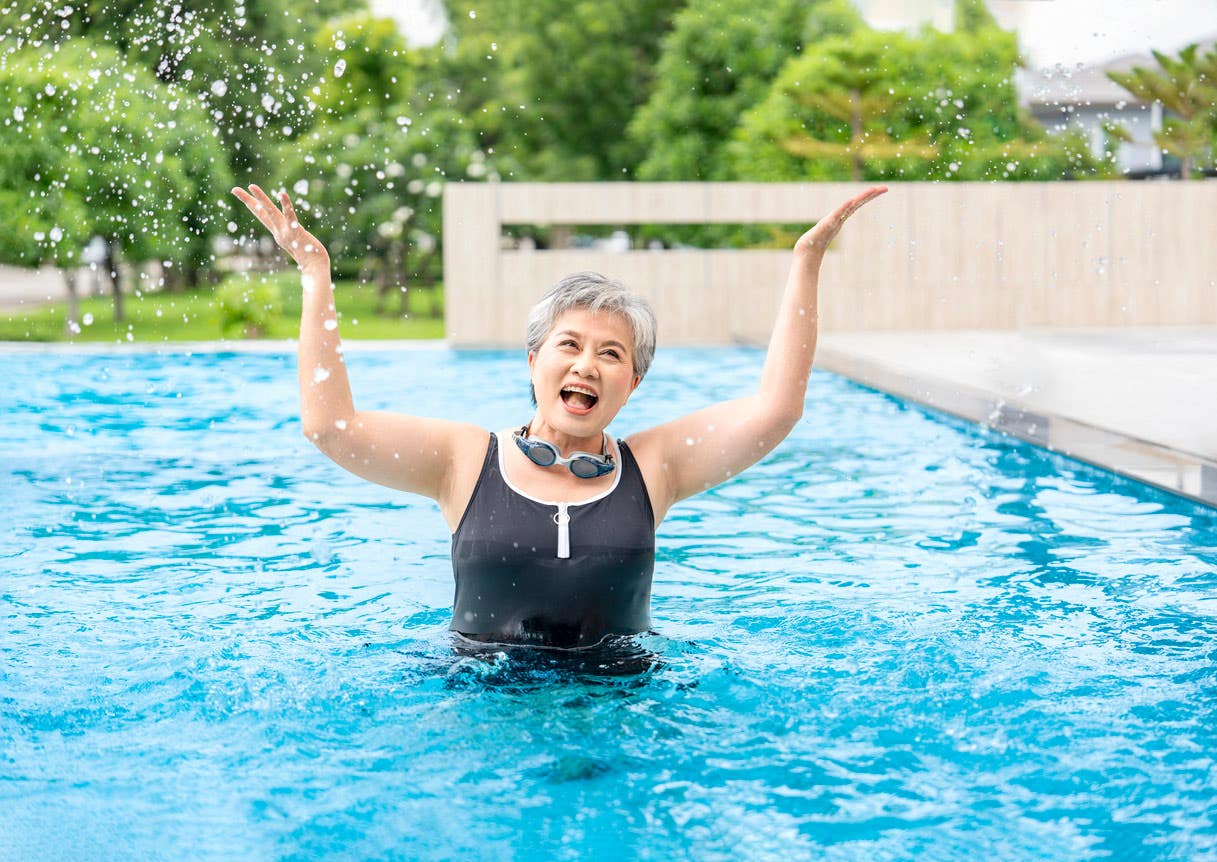
A Beginner-Friendly Swim Workout You’ll Actually Enjoy
- This beginner-friendly swim workout uses simple drills (breathing, balance, pulling water, body rotation) to build confidence, technique, and endurance in the pool.
- It's designed to be scalable and enjoyable for newbies. Read on for the full routine and guidance.
If your only memory of swimming for exercise is gasping through a few punishing laps before calling it quits, it’s time to give it another shot. Done right, swimming can be a refreshing, low-impact workout that builds endurance, tones muscles, and improves cardiovascular health, all while keeping you cool.
The key to a great swim workout? Start small. And if you think that means aiming for 10 laps on day one—think even smaller. “When you decrease the difficulty factor, you increase the motivational factor,” says former Olympian swimmer Jamie Peterkin, who today serves as a competitive aquatics director in Brandon, Florida.
Read on for a step-by-step plan to ease you in with simple drills to build your confidence, hone foundational skills, and develop a rhythm that makes swimming sustainable and enjoyable. Whether you’re brand-new to swimming for fitness or returning after a long break, these expert-backed techniques and tools will set you up for success and might even make swimming your new favorite workout! Let’s dive in.
Drill 1: Regulate Your Breathing
One reason swimming feels so hard to newbies is they hold their breath too long. This increases your heart rate and causes lactic acid to build up in your muscles, leaving you feeling gassed. Peterkin likens it to going out for a 3-mile run, but instead immediately sprinting. “Regulating your breathing at the beginning of every workout is going to help relax the body,” he says. “When you swim relaxed you can swim longer.”
Try this: Spend 3 minutes practicing old-school bobbing: Hold onto the pool wall, submerge—blowing bubbles underwater as if through a straw into a glass—and then raise your head as you breathe rhythmically. This helps establish a relaxed, consistent breathing pattern before you begin.
Drill 2: Find Your Balance
Once you’ve got your breathing under control, the next step is to find your balance in the water. Every swimmer falls into one of two categories: floaters or sinkers. While being a sinker might sound like a disadvantage, it’s simply a cue that you’ll need to kick more to stay afloat.
Try this: Lie on your stomach in the water and see if you can hold a horizontal position. If your legs begin to drop, you’re a sinker. If you’re a sinker, use a swim noodle or kickboard for extra buoyancy and fins to give your kick a boost. Try kicking the length of the pool. “Kick from the hips, allowing it to whip down to the toes with minimal bend in the knees,” says David Hildebrand, a former Division 1 college swimmer who now coaches and competes in U.S. Masters swimming and serves as general manager of Lombard Swim Club. “Maintain the kick just below the surface with less than a foot between the lowest and highest point in the kick.” Visualize your feet staying within the confines of a one-foot box.
Drill 3: Feel the Water
Veteran swimmers know that the real magic happens underneath the water—where your hands and arms press against the water to generate forward momentum. This technique, known as pulling water, makes your stroke more efficient and helps conserve energy so you can swim longer with less effort.
Try this: Hold a swim noodle or kickboard in front of you with your head in or out of the water (depending on your comfort level), and start kicking (with fins if needed). Release your right hand from the noodle or kickboard and point your fingers, slightly apart, down toward the bottom of the pool. After your hand enters the water, with your elbow remaining above your hand and close to the surface of the water, feel the resistance of the water against your palm and forearm as you “catch” or “pull” the water to move your body forward. Repeat with your left hand, alternating sides in a relaxed, controlled rhythm.
Drill 4: Roll to Breathe
To swim freestyle efficiently, seasoned swimmers rotate their bodies with each stroke. This rotation helps you glide through the water and makes it easier to take a breath. “Think of your body like a kayak and your arms like paddles,” says Peterkin. When one paddle dips into the water, the kayak naturally tilts in the opposite direction.
Try this: Hold a swim noodle in front of you with one hand (place opposite hand on your thigh like you are slipping your hand into your pocket) with your face in the water looking slightly forward, breathing out bubbles and gently kicking with fins. Rotate to breathe by shifting your body weight into the water on the side you are holding the noodle with and kick halfway the length of the pool. If you are doing this correctly, your opposite shoulder and hip will rotate to the surface and your ear will rotate out of the water to open up a space to breathe. (Think about a kayak tilting like it's about to tip over; this will help you know how much rotation is enough.) Practice the same on the opposite side to get a feel for body rotation on both sides.
Once comfortable with understanding how to shift your weight to create rotation, try taking a few strokes. Give yourself this simple cue: Pull water with your right hand as you rotate your body toward your left side and enter with your left arm extending in front of your left shoulder. Extend your right arm along your side as you turn your head so you can take a breath. Then initiate pulling water with your left arm, rotating toward your right side and breathing to your left. Continue the pattern.
Drill 5: Develop Rhythm
When you walk, your arms and legs move together in a natural cadence. If your legs are moving quickly, so are your arms. Similarly, your swim stroke can develop that same coordinated flow.
Try this: Swim a lap by putting together everything that you’ve been practicing in the previous drills, staying relaxed as you try to find an even rhythm. At any time if you need to rest in the middle of a lap, Peterkin recommends that you tread water until you feel ready to resume swimming, or, if you’re in a shallow pool, put your feet down and walk toward the wall, keeping your arms under water for some resistance (think underwater bicep curls). Your heart rate will remain elevated, and you’ll get the break you need before you start again. Think of it like taking a walking break when you’re building up your endurance to run continuously. Count how many strokes it takes you to get to the wall so you can use it for comparison. “Stay patient,” says Hildebrand. “Improvement often comes slowly. This is normal.”
Build a Workout
Now that you’ve practiced the foundational drills, here’s how to put them together into a simple, scalable workout.
Stretch
Before you get in the water, Peterkin advises warming up with some basic stretches such as the following.
- Arm swings: While standing, loosely swing your arms from side to side, across your chest.
- Shoulder rotations: Stand or sit tall with arms relaxed at your sides. Slowly roll your shoulders forward in a circular motion 5 to 10 times, then reverse and roll them backward. Keep movements smooth and controlled.
- Knee raises: While standing, bend one knee, interlock your hands around the knee and gently pull it into your chest
- Pigeon stretch: Sit tall in a chair with feet flat on the floor. Cross your right ankle over your left knee, keeping the right foot flexed. Gently press down on the right knee and hinge forward slightly at the hips to deepen the stretch. Hold, then switch sides. (Do not hold pigeon stretch for longer than 10 seconds per side.)
Swim!
Once you’re warmed up, it’s time to dip in! Here’s a suggested sequence for building up your swimming stamina. Note that we’re using “lap” here to mean the length of a 25-yard pool. (In swimmer speak, this is called a “25.”)
| Activity | Length |
| Drill 1: Regulate Your Breathing | 3 minutes |
| Drill 2: Find Your Balance | 1 lap |
| Drill 3: Feel the Water | 1 lap |
| Drill 4: Roll to Breathe | 2 laps |
| Drill 5: Develop Rhythm | 4 laps |
For each lap, count your strokes. Take as much rest as you need between laps to recover, using the pool deck clock or a waterproof watch to measure. You’ll be able to lower both numbers as you progress.
As you become more fit, you will be able to take less rest in between laps. A minute might become 30 seconds down to 10 seconds until you feel like you can keep going without rest.
When you’re ready, swim two laps at a time (called 50s), then four laps at a time (called 100s). Mix things up by changing how much rest you take, how fast or far you swim, which strokes and drills you focus on, and what gear you use. “There’s rarely a reason to repeat yourself,” says Hildebrand.
Gear Up and Dive In
The right gear can make swimming feel less like a chore and more like play, while helping to improve technique and stay motivated. To keep things interesting, choose from these gadgets to stock your swim bag.
Editor’s Note: FOK may collect a small share of sales from some of the links on this page, though it doesn’t influence our product picks.
Speedo Kickboard | $23 at Amazon.com
Spending a lot of time practicing kicking is foundational to any swim practice, says Hildebrand. Experiment with kicking on your front, side and back; kicking fast and slow; kicking with fins and without, he says.
CAPAS Swim Training Fins | $40 at Amazon.com
“I was never a great swimmer so a few years ago I signed up for a swim class,” says Elizabeth Turner, Forks Over Knives editor in chief. “The first thing the teacher told us to get was these fitness fins. They aren't the big fins like scuba divers wear, they're just big enough to make your kick more powerful so you can really move through the water and feel like a good swimmer. They made swim class so much fun.”
Speedo Swim Paddles | $22 at Amazon.com
Wearing swim paddles on your hands can help you get the feel for the proper mechanics of pulling water and can help you pull more water, says Hildebrand.
Pool Noodle | $3 at Target.com
For all of you sinkers (and now you know who you are), add buoyancy to your swim drills by resting a swim noodle under your armpits or hands.
Pull Buoy | $20 at Amazon.com
Peterkin says wearing a pull buoy between your legs can help if you have knee or hip issues and can’t handle too much kicking.
A3 Performance Snorkel | $35 at Amazon.com
A snorkel can help build lung capacity and trains you to keep your head still, only turning it when it’s time to breathe, says Hildebrand. Bite down on the mouthpiece and seal your lips around it. Lower yourself into the water so your mouth is submerged and the snorkel is above. Once you acclimate to the breathing, begin to swim while keeping your head stationary.
Speedo Unisex-Adult Swim Goggle Biofuse 2.0 | $35 at Amazon
“As a swimmer, I’ve found that good swimming googles (built for performance not fancy looks) can really make your time in the water (or break it),” says Lisa Esile, MS, staff writer for Forks Over Knives. “I’ve been very happy with Speedo-brand goggles. These are a little pricey but will likely save you money in the long run, because they’ll hold up well and won’t leak.” For kids, Esile recommends TYR Swimple Tie-Dye Kids' Swim Goggles: “My daughter was very happy with these—cute colors, good seal, and they lasted a few years.”
Samvek Swimming Headphones | $40 at Amazon.com
Some swimmers find mental clarity in the underwater silence, focusing on stroke and lap count and the feel of the water—but if you’d rather have music, a podcast or audiobook to keep you company, these earbuds are for you.
Timex Ironmen Classic Waterproof Watch | $51 at Amazon.com
No pace clock on the deck at your pool? This classic waterproof watch is an easy solution.
About the Author

About the Author
Dana Hudepohl
Join our mailing list
Get free recipes and the latest info on living a happy, healthy plant-based lifestyle.
By providing your email address, you consent to receive newsletter emails from Forks Over Knives. We value your privacy and will keep your email address safe. You may unsubscribe from our emails at any time.
